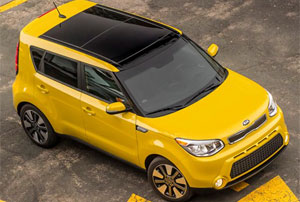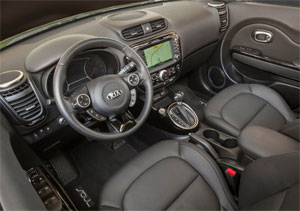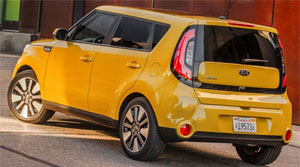2014 Kia Soul
Almost from the moment it arrived here for the 2010 model year, the Kia Soul became one of the brand’s top sellers. Its quirky design, low price, and the cute rodent advertising campaign, quickly made the Soul unforgettable. While aimed at the young, buyers from gen y to baby boomers were drawn to the Soul. Now, there is an all-new second generation Soul. So, let’s see if the 2014 Soul’s mass appeal is intact, or if it’s just grown up and out.
It seems like the Kia Soul has been around for a lot longer than just 4 years. You see them everywhere, no matter what social circle you travel in. But with the 2nd generation 2014 Soul, Kia is looking to see its social standing raised just a bit.
You see, despite originally being aimed at younger buyers, the Soul has proven very popular with mature drivers who found a “Soulmate” in Kia’s roomy bargain box on wheels.
On that point, the new Soul has a much more refined nature. To say the ride quality is greatly improved is an understatement. The chassis is stiffer, and a new subframe, mounted with impact absorbing bushings, and longer travel suspension, smooth things out exponentially.
 The MacPherson strut front suspension has been further revised by moving the stabilizer bar rearward and the steering box forward. An additional 8/10ths of an inch of wheelbase helps as well, though even after all of that, a minority of our drivers still found the ride to be “bumpy”. All agreed it has gotten much quieter inside and is now a fairly comfortable place to spend daily commute time.
The MacPherson strut front suspension has been further revised by moving the stabilizer bar rearward and the steering box forward. An additional 8/10ths of an inch of wheelbase helps as well, though even after all of that, a minority of our drivers still found the ride to be “bumpy”. All agreed it has gotten much quieter inside and is now a fairly comfortable place to spend daily commute time.
Engines choices are the same as before, but both have been tinkered with. The standard and already lethargic 1.6-liter actually rates less horsepower and torque than last year. The 2.0-liter in our Soul Exclaim adds direct injection for the same 164-horsepower but a small but welcomed boost in torque to 151 lb-ft.
Inside, we were very impressed with the upscale redesign. The bargain bling of the original has given way to a much more welcoming atmosphere. Mature drivers will like the new soft touch materials and the next gen. UVO infotainment system. Happily, Kia did keep a few of the Soul’s original youthful elements like the signature pulsating speaker lights.
But the most important change for all age groups is the improved seat comfort and overall roomier and more useful cabin. Cargo capacity is up to 24.2 cubic-ft. behind the folding rear seatbacks, 61.3 cubic-ft. with them flat.
 The decidedly upscale Sun and Sound option package adds a panoramic sunroof, Infinity audio system, Navigation with a large 8-inch touch screen display, and automatic temperature control. And the available Supervision instrument cluster features a 4.3-inch color LCD screen between the tach. and speedometer.
The decidedly upscale Sun and Sound option package adds a panoramic sunroof, Infinity audio system, Navigation with a large 8-inch touch screen display, and automatic temperature control. And the available Supervision instrument cluster features a 4.3-inch color LCD screen between the tach. and speedometer.
Push button start, heated and ventilated leather front seats, heated rear seats, and heated steering wheel are all offered as well.
Kia also wisely decided not to tinker too much with the Soul’s unique exterior styling, sticking with the same boxy bulldog shape as before, even though all sheet metal is new. It’s now more rounded, less squared off, and a tad more aggressive thanks to the larger openings up front and a wider stance.
LED positioning lights are standard on Exclaim model, but the HID headlights come as part of the “Whole Shebang Package”. Fenders are still very pronounced and the blacked-out A-pillars give a wraparound visor look to the greenhouse.
Exclaim trim also adds a halo treatment to the high mounted tail lights that lend a 70’s disco era sci-fi look.
Standard wheels are 16-inches, with the Exclaim riding on 18’s. But, you won’t exactly be spinning those wheels off the line too much, as power, even with the 2.0-liter, is adequate at best. Sprints to 60 take a sleepy 8.9–seconds.
The 1.6-liter Soul comes with a 6-speed manual, but a 6-speed automatic transmission is standard with the 2.0. Shifts were soft, and power slow to build on the way to a quarter mile time of 17.0-seconds and 84 miles-per-hour.
But once we started tackling the cones, we began to find some “soul”-ful fun. Despite the more refined ride of the new Soul, handling has also improved. Turn in is quick, and both under and over steer can be found if you go looking. Brake performance is also impressive with consistent stops from 60 averaging a short 118-feet.
 Government Fuel Economy Ratings are little changed. The 2.0-liter rates 23-City, 31-Highway, and 26-Combined. Fortunately even our lead footed drivers were able to achieve 26.8 miles-per-gallon of Regular in a mixed loop of driving. The Energy Impact Score is good at 12.7-barrels of yearly oil usage and 5.6-tons of CO2 emitted.
Government Fuel Economy Ratings are little changed. The 2.0-liter rates 23-City, 31-Highway, and 26-Combined. Fortunately even our lead footed drivers were able to achieve 26.8 miles-per-gallon of Regular in a mixed loop of driving. The Energy Impact Score is good at 12.7-barrels of yearly oil usage and 5.6-tons of CO2 emitted.
Even with prices sneaking up just a little, value continues to be a strong selling point; with base Souls starting at $15,695. Mid-level Plus models, at $19,195 and top-of-the-line Exclaims start at $21,295.
The Soul became an unqualified success in a single generation. And after some soul searching of our own, we conclude that the mostly very well executed updates will expand the 2014 Kia Soul’s mass appeal even more.
Specifications
- Engine: 2.0-liter
- Horsepower: 164
- Torque: 151 lb-ft.
- 0-60 mph: 8.9 seconds
- 1/4 mile: 17.0 seconds @ 84 mph
- EPA: 23 mpg city/ 31 mpg highway
- Energy Impact: 12.7 barrels of oil/yr
- CO2 Emissions: 5.6 tons/yr
2024 Polestar 2
More Range And More Power For The Polestar 2
Volvo is well on their way to making the transition to an all-electric brand, but their sister-brand Polestar is already there. Now, we’ve spent lots of time in their all-wheel drive, five-door Polestar 2, having tested it in 2021, and a year later when a two-wheel drive version arrived. But, EV updates are coming quickly. So, let us be your guide for all that’s new with the Polestar 2.
While we are driving more EVs than ever, we’ve also been spending a lot of time recently circling back to ones we’ve previously tested. As in this new era of electrified vehicles, significant updates are arriving quickly, with R&D investments increasing and retrofitting them easier than ever. This is often done through software updates that can even be accomplished over the air. For 2024, the Polestar 2 has indeed gotten some software updates, but some physical ones as well.
Clearly aimed directly at Tesla’s Model 3 when it arrived; the Polestar 2’s build quality was vastly better, but range definitely came up short. So, addressing that was priority No. 1; and for ’24 the Polestar can travel up to 20% farther than before while consuming 9% less energy, and when it comes time to charge it back up, it can do that 34% faster too.
Range in the Single Motor version increases from a max of 270 to 320 miles thanks to a larger 82-kWh battery pack, and that solitary motor now powers the rear wheels, not the front wheels. It’s also bigger, coming in at 220 kW compared to the previous 170 kW front-wheel drive version, going from 231 to 299 horsepower.
Dual Motors keep the same 78-kWh battery, but still sees a boost from 260 to 276 miles and takes advantage of the larger rear motor for a new combined 310-kW output with 421 horsepower. Our test car has the added Performance Pack, which uses an additional 35 kW to deliver 455 horsepower and 546 lb-ft of torque, though max range drops to just 247 miles.
The new battery in rear-drive 2s will also charge faster, now accepting up to 205 kW for an 80% charge in 20 minutes; max for dual-motors stays at 155 kW, which puts an 80% charge at 34 minutes. Using 32 kWh of electricity per 100 miles, the Dual Motor earns a good efficiency rating.
The [Polestar] 2 has always been one of the most enjoyable EVs to drive, even more so now with that additional power coming from the rear motor.
Unfortunately, extremely cold temperatures kept us from seeing that increased range, as we were only on pace for about 194 miles in our test.
The 2 has always been one of the most enjoyable EVs to drive, even more so now with that additional power coming from the rear motor. And especially when equipped with the Performance Pack as it not only includes more power, but adds 20-inch forged wheels, upgraded brakes, and adjustable Ohlins Dual Flow Valve performance dampers. It greatly improves handling prowess without affecting ride quality, and is easily worth the $5,500 charge if you at all enjoy driving.
Even on a 20-degree track day there was plenty of grip through our handling course. No understeer or oversteer, and lots of feedback through the wheel. There was a nice, strong launch off the line that properly planted us firmly in the seat, and rocketed us to 60 in 4.5 seconds. Power delivery stayed pretty intense up until about 80 mph when there was a definite tapering off. Still, it was a 13.4-second quarter-mile at 102 mph; smooth, quiet, and stable the whole way.
When this car debuted, its Google-based infotainment setup was a novelty, but since then, more and more manufacturers are just “Googling it” so it doesn’t seem out of place at all. The wireless phone charger is easy to access, and there’s a great Harmon/Kardon sound system and panoramic sunroof to enhance the in-cabin experience. Exteriors have also been enhanced with a smooth grille insert and new wheel choices.
Hatchback practicality means 14.3 cu-ft of easy to access cargo space with split-folding seatbacks for longer items and expanding the space to 38.7 cu-ft. Plus, there’s even a sizeable storage bin up front under the hood.
Single Motor Polestar 2 pricing now starts at $51,300, with Dual Motors starting at $56,700; topping out at $64,400.
For a car manufacturer that hasn’t even been around for a decade yet, Polestar has kept itself busy, totally transforming their latest model in just a few years, making the 2024 Polestar 2 even more appealing. They are certainly off to a good start, and with a host of Polestars just over the horizon, including some all-important utility vehicles, this star will be shining even brighter.
Specifications
As Tested
- Motor Setup: Dual Motor
- Horsepower: 455
- 0-60 mph: 4.5 seconds
- EPA Range: 247 miles
- Efficiency : 32 kWh / 100 miles
- Battery Size: 78-kWh
- Torque: 546 lb-ft
- 1/4 Mile: 13.4 seconds at 102 mph
- MW Test Loop: ~ 194 miles
- Peak Charging Rate: 155 kW











































